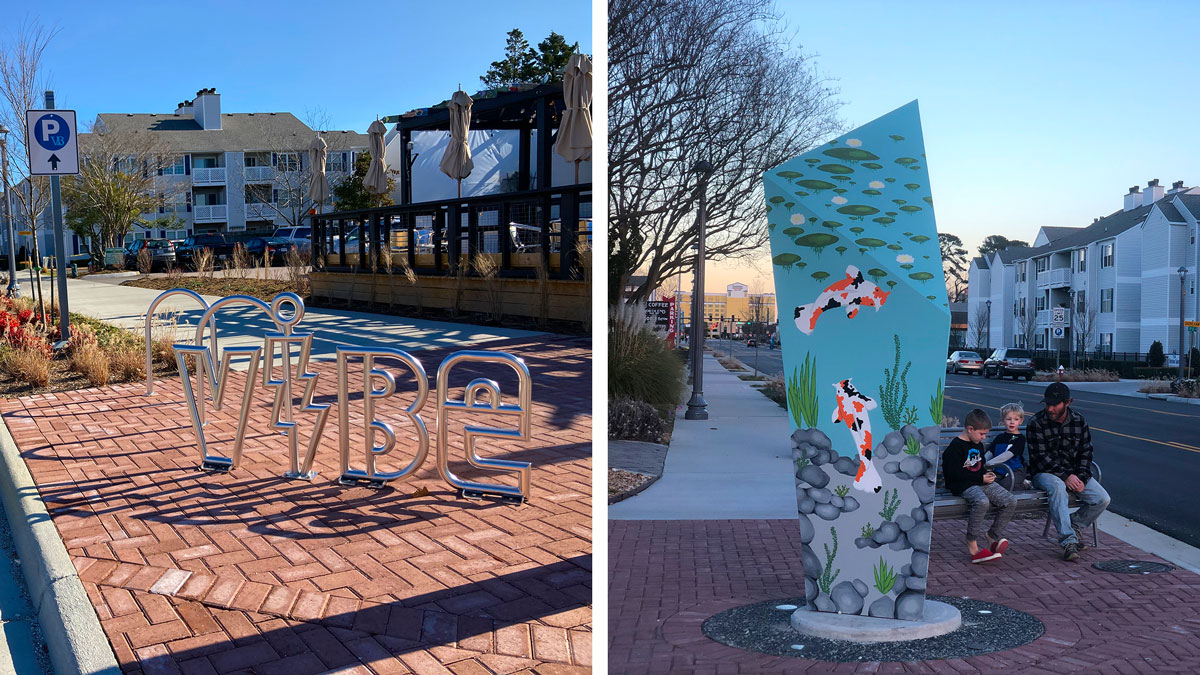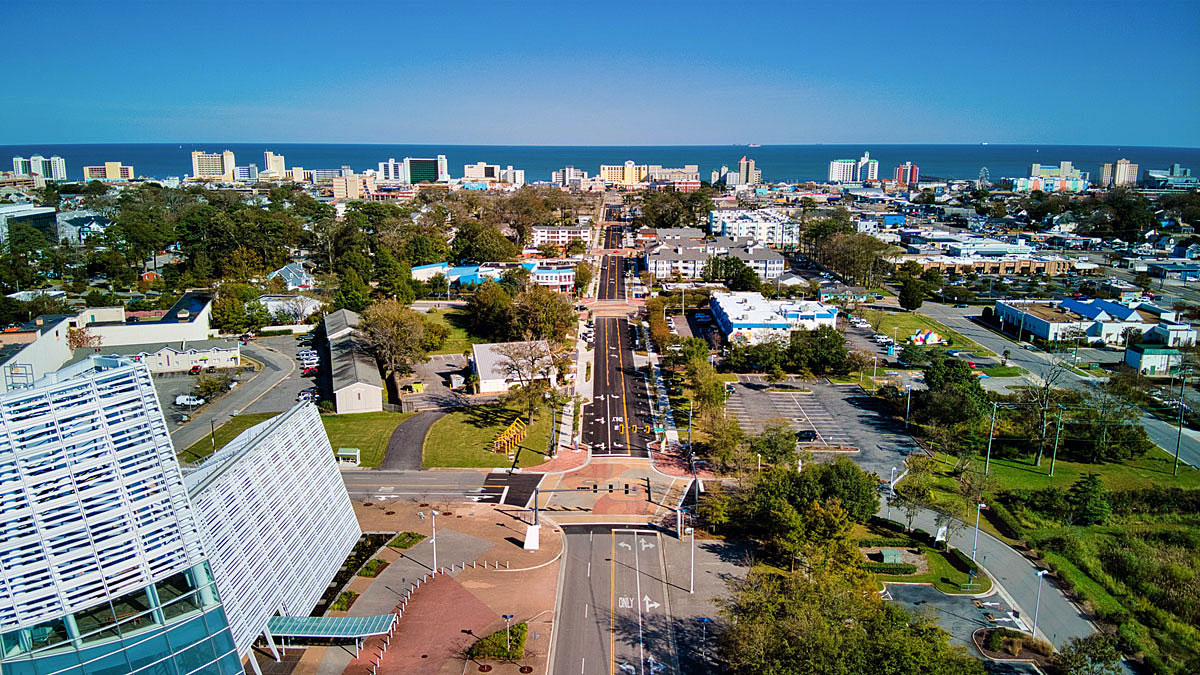Best Practices for Streetscape Design that Cultivates Community
Video by Lyfted Media courtesy of ViBe Creative District.
Well-designed streetscapes provide a wealth of benefits for their respective communities. In more recent years, we have seen a synergistic shift toward design strategies that activate the surrounding area and create a sense of place for citizens. In Virginia Beach’s ViBe District, the new designs of 18th and 19th streets have done just that – improving mobility while generating a thriving subcommunity of commerce, art, and nightlife.
w
With a prime location in the heart of Virginia Beach’s resort area and ViBe District, 18th and 19th Street have some unique qualities. They also serve as a critical link connecting the Convention Center and new Sports Center to the resort area and oceanfront. One of the early strategies identified to achieve the ViBe vision of spurring economic development was to create a walkable urban district with free parking, sidewalks, lighting, trees and shrubbery, and amenities such as seating, bike racks, signage, and unique canvases for local artists. The following considerations have made 18th and 19th Street a success:
Designing for Safety and Accessibility
Mobility and safety were carefully considered when approaching the new design of these thoroughfares, as both streets originally lacked critical components such as continuous sidewalks, lighting, and ADA accessibility. It was important for the city to create a functional, inclusive, and safe road for all modes of transportation, including vehicles, bicycles, and pedestrians.
To achieve these outcomes, our transportation experts worked diligently with city staff to gain valuable input and engage project stakeholders to create a sensible urban streetscape with new pedestrian lighting, bike lanes, wayfinding signage, gateway markers, verges, and paver sidewalks.

Left: A custom bike rack in the ViBe District. Right: Locals relax on a bench beside one of various hand-painted canvas markers.
Creating a Canvas
Highlighting the local art scene by incorporating innovative ‘canvases’ was a priority. To achieve the ViBe vision, our landscape architects incorporated custom bike racks, benches, custom trash bins, murals, and artistic canvases, signage, and markers into the design to engage local artists and bring the area to life.
All existing public and private infrastructure within the corridors was replaced to provide a new storm drainage system, with an emphasis on green infrastructure and overhead to underground utility relocations including duct bank, roadway and pedestrian lighting, water and sewer replacements, and traffic signal replacements. New trees and shrubs were added to enhance the surrounding environment and establish a strong sense of place.
Accommodating Events
While providing the necessary roadway and streetscape improvements along the four blocks of 18th Street, the team first took into consideration a safe, sensible, and accessible design for diverse activities while simultaneously promoting and encouraging the development of ideas within the ViBe District. Today, the blocks at the west end of 18th Street serve as a central hub for the entire district. This area is closed periodically for special city events and popular local celebrations such as the city’s “First Fridays,” as well as other frequent pop-ups and farmers’ markets. During these closures, tents and vendors line the city owned “parklet,” a centerpiece of the ViBe District, adjacent to the north side of the street. Within this area, the team designed a walkable environment complete with custom artistic benches, art areas for transitioning exhibits, and electric and water services that can be utilized by various vendors and artists during events.

An aerial view of 19th Street, spanning from the Virginia Beach Convention Center to the oceanfront resort area. Photo by Lyfted Media courtesy of ViBe Creative District
Strengthening Community Connections
The streetscape improvements to these corridors thread an important connection between the oceanfront and resort area, the Convention Center, and the new Sports Center. Over the years, Clark Nexsen has been a close partner to the City of Virginia Beach in developing this network of facilities, providing full-service transportation and vertical design. The role of 18th and 19th Streets in creating an engaging, connected experience has a tremendous positive impact on the entire district. These projects have steadily transformed the area from a seasonal vacation spot to a year-round, urban hub, full of art, food, and events for locals and tourists alike.
Design in Action: Navigating COVID-19
Not long after construction was complete on 19th Street, COVID-19 began to impact industries of all types. After the initial lockdown and businesses started reopening, many owners in the local food and beverage industry were forced to get creative with their dining in an outdoor setting. The new, expanded sidewalks on 19th Street provided a distanced, traversable path for citizens to walk along as well as amplified space for outdoor patio dining to be set up.
“The project came at a convenient time for my business in the midst of all the new COVID policies for restaurants. With the newly widened sidewalks, I was able to have the space I needed to create an alternative outdoor dining area for my customers which I’m very thankful for” said Dwayne Appleton, owner of Java Surf Café & Espresso Bar.
When looking at urban infrastructure, good streetscapes play an important role in mobility and safety for vehicles, pedestrians, and bicycles. By examining these spaces through a holistic lens, we can design strategically within communities to create well-rounded streetscapes that contribute to enhanced public health, benefit the environment, improve quality of life, and stimulate economic growth.
Wes Parker, PE, PTOE, is a senior transportation engineer in our Virginia Beach office with 13 years of design and management experience on a wide variety of transportation and traffic engineering projects. His experience as a project or task manager for numerous on-call, roadway, and trail projects has contributed to providing clients with timely, cost effective, and detailed transportation designs for both urban and rural environments. To speak with Wes, please call 757.961.7726 or email wparker@clarknexsen.com.
